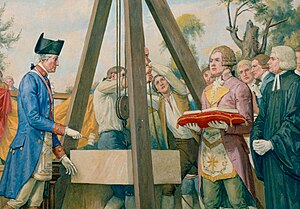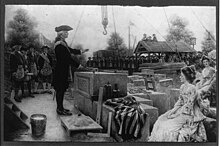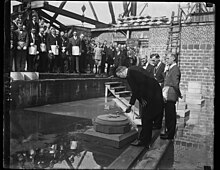
Freemasonry or Masonry refers to fraternal organisations that trace their origins to the local guilds of stonemasons that, from the end of the 14th century, regulated the qualifications of stonemasons and their interaction with authorities and clients. Modern Freemasonry broadly consists of two main recognition groups: Regular Freemasonry, which insists that a volume of scripture be open in a working lodge, that every member professes belief in a Supreme Being, that no women be admitted, and that the discussion of religion and politics do not take place within the lodge; and Continental Freemasonry, which consists of the jurisdictions that have removed some, or all, of these restrictions.

A Masonic lodge, often termed a private lodge or constituent lodge, is the basic organisational unit of Freemasonry. It is also commonly used as a term for a building in which such a unit meets. Every new lodge must be warranted or chartered by a Grand Lodge, but is subject to its direction only in enforcing the published constitution of the jurisdiction. By exception the three surviving lodges that formed the world's first known grand lodge in London have the unique privilege to operate as time immemorial, i.e., without such warrant; only one other lodge operates without a warrant – the Grand Stewards' Lodge in London, although it is not also entitled to the "time immemorial" title. A Freemason is generally entitled to visit any lodge in any jurisdiction in amity with his own. In some jurisdictions this privilege is restricted to Master Masons. He is first usually required to check, and certify, the regularity of the relationship of the Lodge – and be able to satisfy that Lodge of his regularity of membership. Freemasons gather together as a Lodge to work the three basic Degrees of Entered Apprentice, Fellowcraft, and Master Mason.
The history of Freemasonry encompasses the origins, evolution and defining events of the fraternal organisation known as Freemasonry. It covers three phases. Firstly, the emergence of organised lodges of operative masons during the Middle Ages, then the admission of lay members as "accepted" or "speculative" masons, and finally the evolution of purely speculative lodges, and the emergence of Grand Lodges to govern them. The watershed in this process is generally taken to be the formation of the first Grand Lodge in London in 1717. The two difficulties facing historians are the paucity of written material, even down to the 19th century, and the misinformation generated by masons and non-masons alike from the earliest years.

The George Washington Masonic National Memorial is a Masonic building and memorial located in Alexandria, Virginia, outside Washington, D.C. It is dedicated to the memory of George Washington, the first president of the United States and a Mason. The tower is fashioned after the ancient Lighthouse of Ostia in Ostia Antica. The 333-foot (101 m) tall memorial sits atop Shooter's Hill at 101 Callahan Drive. Construction began in 1922, the building was dedicated in 1932, and the interior finally completed in 1970. In July 2015, it was designated a National Historic Landmark for its architecture, and as one of the largest-scale private memorials to honor Washington.

The George Washington Inaugural Bible is the Bible that was sworn upon by George Washington when he took office as the first president of the United States on April 30, 1789. The Bible has subsequently been used in the inauguration ceremonies of several other U.S. presidents.

The North Carolina State Capitol is the former seat of the legislature of the U.S. state of North Carolina which housed all of the state's government until 1888. The Supreme Court and State Library moved into a separate building in 1888, and the General Assembly moved into the State Legislative Building in 1963. Today, the governor and his immediate staff occupy offices on the first floor of the Capitol.

The Most Worshipful Grand Lodge of Ancient Free and Accepted Masons of the Commonwealth of Massachusetts, commonly referred to as the Grand Lodge of Massachusetts and abbreviated GLMA, is the main governing body of Freemasonry within Massachusetts, and maintains Lodges in other jurisdictions overseas, namely Panama, Chile, the People's Republic of China, and Guantanamo Bay Naval Base, Cuba.

The House of the Temple is a Masonic temple in Washington, D.C., United States, that serves as the headquarters of the Scottish Rite of Freemasonry, Southern Jurisdiction, U.S.A.

Richard Vaux was an American politician. He was mayor of Philadelphia and served for less than a year as a member of the U.S. House of Representatives from Pennsylvania in the early 1890s.

The Detroit Masonic Temple is the world's largest Masonic Temple. Located in the Cass Corridor of Detroit, Michigan, at 500 Temple Street, the building serves as a home to various masonic organizations including the York Rite Sovereign College of North America. The building contains a variety of public spaces including three theaters, three ballrooms and banquet halls, and a 160 by 100 feet clear-span drill hall.
In Craft Freemasonry, sometimes known as Blue Lodge Freemasonry, every Masonic lodge elects or appoints Masonic lodge officers to execute the necessary functions of the lodge's life and work. The precise list of such offices may vary between the jurisdictions of different Grand Lodges, although certain factors are common to all, and others are usual in most.
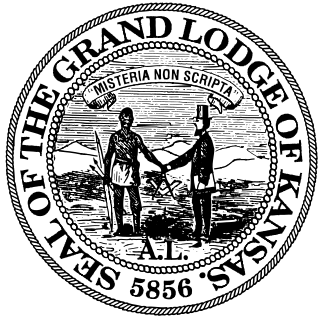
The Grand Lodge of Kansas Ancient Free & Accepted Masons is the governing body that supervise Freemasonry in the U.S. state of Kansas. The Grand Lodge of Kansas is headquartered in Emporia, Kansas.
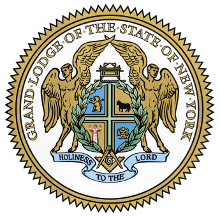
The Grand Lodge of New York is the largest and oldest independent organization of Freemasons in the U.S. state of New York. The headquarters of the Grand Lodge is the Grand Lodge Building located at 23rd Street in Manhattan.

William Tefft Johnson, Jr., better known as Tefft Johnson, was an American stage and film actor, and film director and screenwriter. He appeared in 131 films between 1909 and 1926.

Masonic ritual is the scripted words and actions that are spoken or performed during the degree work in a Masonic lodge. Masonic symbolism is that which is used to illustrate the principles which Freemasonry espouses. Masonic ritual has appeared in a number of contexts within literature including in "The Man Who Would Be King", by Rudyard Kipling, and War and Peace, by Leo Tolstoy.

The Masonic Temple is a historic Masonic building in Philadelphia. Located at 1 North Broad Street, directly across from Philadelphia City Hall, it serves as the headquarters of the Grand Lodge of Pennsylvania, Free and Accepted Masons. The Temple features the Masonic Library and Museum of Pennsylvania, and receives thousands of visitors every year to view the ornate structure, which includes seven lodge rooms, where today a number of Philadelphia lodges and the Grand Lodge conduct their meetings.
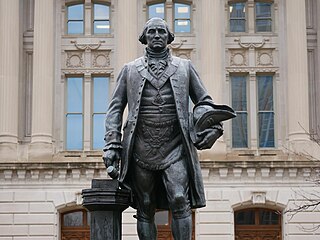
George Washington is a public artwork by American sculptor Donald De Lue, located on the grounds of the Indiana Statehouse, in Indianapolis, Indiana, United States. The bronze statue of George Washington that occupies the Indiana Statehouse south lawn is one of several copies of a 1959 original wax cast at the Modern Art Foundry in Long Island, New York.

The Insurance Building is a government building in Olympia, Washington that houses the offices of the Insurance Commissioner and State Auditor.
Pedro Pablo Casanave , also known as Peter Casanave, was a prominent Spanish American merchant and politician who served as the fifth mayor of Georgetown in Washington, D.C. He was a member of the Georgetown Common Council. Casanave, a Master Mason, is particularly remembered for presiding over the ceremonial laying of the cornerstone of the President's House, later to be known as the White House, on October 12, 1792. Other information about him remains scarce.
The Grand Lodge of Ancient, Free and Accepted Masons of North Carolina, also known as the Grand Lodge of North Carolina, was founded 12 December 1787. Previously, it was the Provincial Grand Lodge of North Carolina, being under jurisdiction of the Premier Grand Lodge of England since 14 Jan 1771. It is currently composed of 354 active lodges across the 100 counties of North Carolina. The Grand Lodge recognizes its Prince Hall counterpart, The Most Worshipful Prince Hall Grand Lodge of North Carolina and its Jurisdictions, Inc., and maintains co-territorial jurisdiction and encourages visitation between the two entities.
